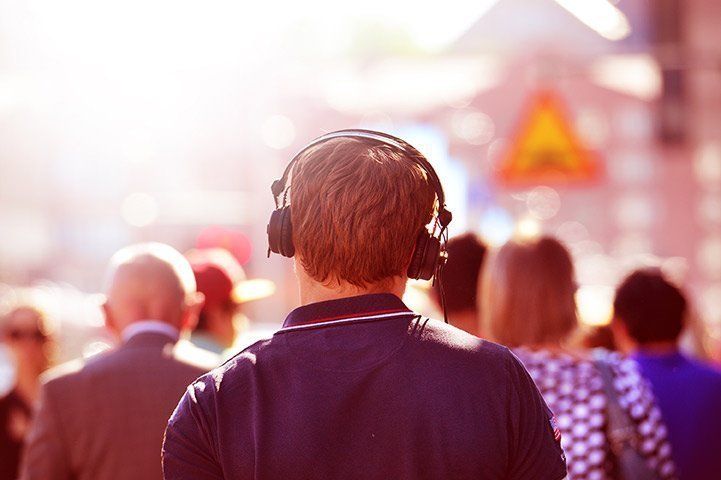
WELCOME TO CASCADE HEARING & AUDIOLOGY

Latest News

The tick of a clock. Birds chirp. Children’s whispers. We live in a world full of sounds, all important and adding joy to our lives. Hearing loss can inhibit a person’s ability to experience the sounds around them. And, this affects not only their lives, but also the lives of those around them. Hearing loss can happen gradually or there can be some sudden hearing loss, usually developing over several years with voices that are mumbled rather than clear and distinct. Social situations with groups or large gatherings become frustrating and embarrassing instead of fun and enjoyable. Because hearing loss can develop so slowly many people don’t realize the extent of their loss or are unaware of exactly how many sounds of life they are missing.
Typically, it is the friends and family members closest to the person who notice the hearing loss, sometimes even before the person himself is aware of a hearing loss. Nerve hearing loss cannot be reversed, but it can be managed and the best way to effectively manage a hearing loss is to catch it early. The sooner a hearing loss is identified, the more successful the road towards hearing rehabilitation. Cascade Audiology & Hearing Aid Services, PC will be with you every step of the way towards improved hearing.
The Three types of Hearing Loss
Although there are several types of hearing loss, generally they fall into one
of three categories: conductive, sensorineural and mixed hearing loss, based on
the location of the problem in the auditory system.
- Sensorineural – The most common form of hearing loss is sensorineural hearing loss, commonly referred to as “nerve loss.” This happens when the inner ear and auditory nerve do not properly transmit their signals to the brain.
- Conductive – Can often times be medically treated. If we identify this type of hearing loss we will refer you to a physician for consultation.
- Mixed hearing loss – Some people have a conductive loss and a sensorineural loss in the same ear(s) at the same time (for example, an ear infection and noise-induced hearing loss). When this occurs, the hearing loss is referred to simply as “mixed.”

Tinnitus
is a noise in your ear that can be constant or periodic in nature. Up to 20% of
the world’s population may have tinnitus with 85% demonstrating some degree of
hearing loss that is justification for a thorough hearing test. Yes, it is
possible to have a hearing loss without being aware of it. Hearing testing is
highly recommended. Causes?
Tinnitus is similar to any chronic annoying pain. In one sense, the nerve is
making it known to the brain that some sort of trauma has occurred to the nerve
that may involve outer hair cells in the cochlea, the 8th nerve or the pathway
to the temporal lobe in the brain. However, tinnitus can be present with
factors involving the outer ear like a foreign object, wax, middle ear disease
or infection. Even a loose hair touching the eardrum can create a scratchy or
popping sound that can be described as tinnitus. Some tinnitus is described as musical
tones, roaring, chirping, buzzing frying, clicking, hissing, or pulsating
sound, etc. Most tinnitus is described as a "ringing" sound often at
the frequency where damage may have occurred.
- Loud noise exposure: At the top of the list for causes for tinnitus and certainly very high in Montana is shooting guns and the use of loud equipment. Any noise that you have to shout over to be heard may generally be considered to be damaging to the ears. It is best to avoid loud noise or dampen it with appropriate ear protection. Important: know the sound levels and read the NRR rating for any ear protection that is chosen. Become familiar with OSHA standards for acceptable loud noise exposure. Be sure that ear protection is fitting properly and that the full benefit of protection is being received.
- Sinus problems: Hearing may decrease or alternate between ears with a pressure on the same side of the head as the sinus Problem. The problem may be more obvious upon waking in the morning or on the same side that you sleep.
- Degeneration of the bones in the middle ear: This can cause a noise in the ears.
- Injury to the ear, head or neck: Injury to the head or neck may involve more of a centralize non-specific tinnitus. This condition may occur with dizziness, headache, nausea or memory loss.
- Infections in the ear:
- Meniere's Disease: True endolymphatic pressure often includes: dizziness, low frequency hearing loss, reduced speech recognition, periodic tinnitus accompanied by drop in hearing, fullness or pressure in the ear and sensitivity to loud sounds. Sodium is high on the list for possible cause of this condition as sodium affects fluid levels in the body.
- Thyroid Disease/hypo/hyper thyroid
- Ototoxic substances May cause damage to hair cells resulting in tinnitus.
o a. Certain antibiotics-mycins
o b. Medications/prescription drugs: Read the labels and side effects.
o c. Substances: sodium, Quinine, Aspirin, caffeine’s, nicotine, alcohol, ibuprofen
o d. Chemotherapy, radiation
- High blood pressure or heart disease pulsatile tinnitus: Approximately 3%. Pulsatile tinnitus is a pulsating sound in the ear that occurs with the heartbeat. This type of tinnitus may involve a vascular condition. The condition may be detected with a stethoscope on the side of the neck. Causes are known to be hypertension, heart murmur, glomus tumor, eustachian tube disorders (from the ATA), etc. If pulsatile tinnitus is a problem, it is best to see a physician.
- Neural Tumor or compression of the nerve. Occasionally, tumors occur and cause compression of the nerve. The most common characteristic of a tumor is unilateral tinnitus.
- TMJ: Jaw related tinnitus.
- Type II Diabetes. Diabetes is a common cause of hearing loss and tinnitus.
- Presbycusis: Age related hearing loss is most commonly genetic.
- Stroke: If tinnitus shows up with a stroke, a hearing loss may also be identified. However, this may not always be the case.
- Lyme disease, fibromyalgia, and thoracic outlet syndrome according to the ATA
Why is tinnitus a problem?
Many tinnitus sufferers describe the sound as being obnoxious or annoying,
especially if it occurs intermittently and appears to get loud. In this manner,
it is much the same as a chronic pain. Tinnitus can be a distraction and
interfere with daily activities mostly because it causes emotional fears,
anxiousness or fear of hearing loss. It does not technically interfere with
hearing. Mostly tinnitus may be distracting, cause loss of focus of attention
or affect emotional sensitivity more than it reduces hearing. If hearing is
reduced with tinnitus, it is likely that there is a temporary hearing
impairment or permanent hearing loss. In more severe cases, the primary concern
is for sleep interference or interference with occupation and daily activities.
What to do?
- Eliminate or reduce loud noise exposure as a possible cause! Use ear protection with loud noise.
- Consider a hearing test to see if there is a hearing loss associated with tinnitus that you may or may not be aware of.
- Consider a medical evaluation to be certain that there is not an underlying medical condition or substance as a cause.
- A hearing aid in circumstances where warranted can reduce the chronic presence of tinnitus by masking with environmental sound that was not heard previous to its use. A hearing aid generally does not cause tinnitus to vanish. The tinnitus will likely be more apparent when not wearing the hearing aid at night. 16% success is noted with hearing aids in the research. The hearing aid in most situations is likely to improve upon the stress of tinnitus by helping with hearing.
- Tinnitus Masker: This is an instrument that can be used to substitute a static like noise to cover up the tinnitus if tinnitus is annoying enough to interfere with sleep or daily activities. Habituation is a method of helping the person to adjust. The masking noise is introduced and subsequently gradually removed to help the person unconsciously adjust to tinnitus. In this manner, the tinnitus is not altered in any way. The person's conscious or unconscious attendance to it is altered to the point of acceptance. Studies suggest 64-84% success. Search: "tinnitus pillow maskers" to find pillows that are designed to help.
- Masking out the sound with a radio set in between stations or with some other noise producing instrument. Using an MP3 player with substituted sounds such as waterfalls, cricket noise or filtered noise.
- Counseling, therapy or tinnitus retraining: There is no known cure for tinnitus that does not have an obvious identifiable physiological cause that can be treated medically or by removing the cause. Most people must learn to adjust to the sound in their head that may remain for the rest of their lives. For most people, the treatment is some form of adjustment. Once tinnitus remains constant, the probability that it will remain is likely. Cognitive behavior therapy may be considered in such instances or retraining with the use of a tinnitus masker. An 80 % success rate has been claimed.
- Medication Some anti-anxiety medications may help. One study supported a 76% success rate in comparison to 1% placebo group. The primary concern is side-effects of drugs. Medication may be suggested if other approaches are not successful primarily to help with sleep or anxiety. It is advisable to see a physician for consultation regarding any medications to assist with sleep disturbance.
- Alternate therapies Some alternative approaches may help.
Consider: The ATA (American Tinnitus Association) offers; books, articles,
tinnitus centers and self -help groups Fifth International Tinnitus Seminar
offers; research International Tinnitus Study Group; publishes a newsletter
This information from a diversity of sources and: ATA Hearing Review A Brief
Overview of Tinnitus for Dispensing Professionals, Jay and McSpaden, PHD
Hearing Review, August 2007 Hearing Journal Tinnitus: Among Many Uncertainties,
A Message Of Hope is One Constant, David Kirkwood, June 1995 Hearing Journal.

Hearing aids are able to identify characteristics of speech that
are different than characteristics of noise. However, many characteristics of
noise may be in the speech range and not totally separate from speech.
Noise management is not noise cancellation. Noise management programs
are subtle. They may help some. However, these programs do not
eliminate or reduce substantially background noise. It is not unusual to
run across false claims (advertisements) about reduction of background
noise.
Directional hearing aids are actually more effective at reducing background
noise to the rear than a noise management programs.
Noise management has become more sophisticated and works off of several
parameters. With full capacity of multi memory and directionality, this
is how it works.
- Directionality picks up toward the person you are facing and dampens sound to the rear.
- A rapidly changing speech signal is attended to while non-speech characteristics of a constant noise is dampened.
- Low frequencies are reduced to decrease the masking affects that low frequency sounds(vowels) have on consonantal high frequency sounds (sh, p, t, s, f, th, etc).
- Soft high frequency sounds(sh, p, t, s, f, th, etc) that are difficult to hear are increased.
- Loud high frequency sounds that are obnoxious are dampened and smoothed to create less harshness. *peaks and valleys in noise may be smoothed.
- Transitions from noisy and loud to soft and quiet is more seamlessly changed so that changes are not real obvious or obnoxious.





